Catocala semirelicta
Catocala semirelicta
kah-TOCK-uh-lahmmsem-ee-reh-LIK-tuh
Guenee, 1852
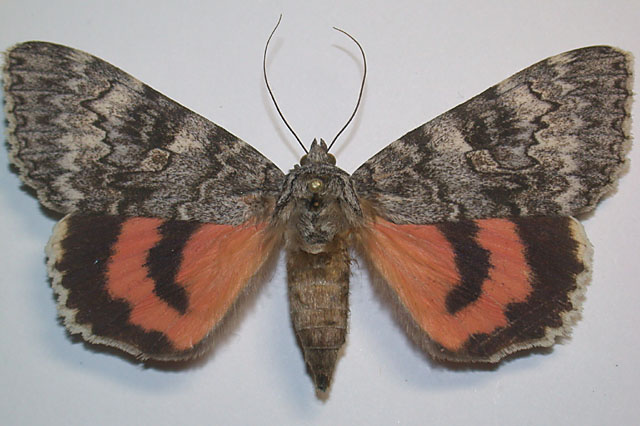
Catocala semirelicta female, LaMalbaie, Quebec,
courtesy of Pierre De Tonnancour, August 20, 1994, via Pierre Legault.
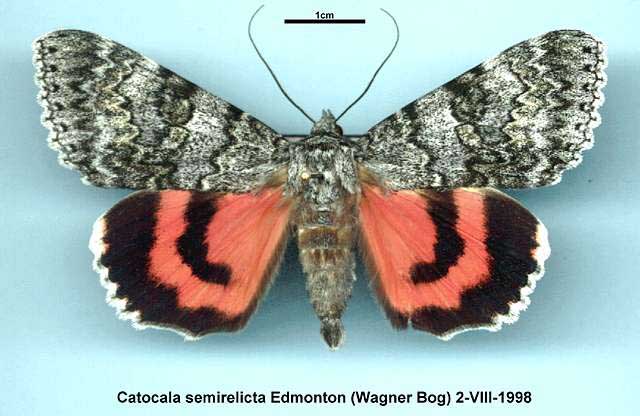
Catocala semirelicta, Wagner Bog, edmonton, Alberta, August 2, 1998, SEM.
This site has been created by Bill Oehlke at oehlkew@islandtelecom.com
Comments, suggestions and/or additional information are welcomed by Bill.
| TAXONOMY:
Superfamily: Noctuoidea
Family: Noctuidae
Group: Noctuinina
Subfamily: Catocalinae
Genus: Catocala, Schrank, 1802
|
DISTRIBUTION:
There are also reports from
Arizona,
California,
Idaho,
Michigan,
Minnesota,
Nebraska,
Nevada,
New Hampshire,
New Mexico,
North Dakota,
Oregon,
South Dakota,
Vermont,
Wisconsin and
Wyoming.
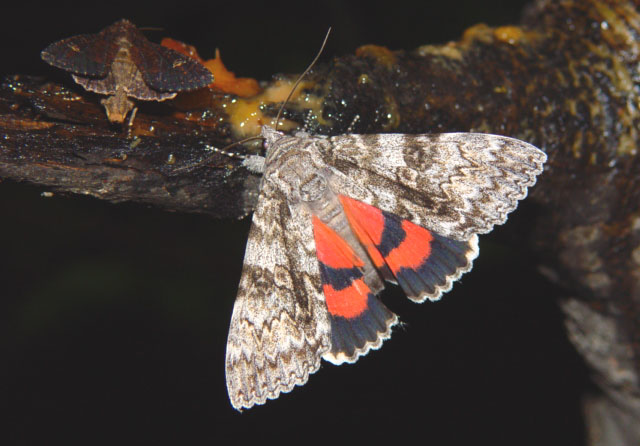
Catocala semirelicta, Peterborough, Ontario, August 16, 2004,
courtesy of Tim Dyson copyright.
Scott Shaw reports semirelicta is taken (not common) "on Pole Mountain, in the Medicine
Bow Forest, Wyoming, about 10 miles east of Laramie near I-80 in the mountain willow bogs."
Catocala hippolyta, Catocala nevadensis and Catocala pura
may all be synonymous with Catocala semirelicta,
extending its range into northern and central eastern
California.
Visit Catocala semirelicta, Wallula HMU, Walla Walla County, Washington,
August 1, 2009, courtesy of Mike Denny.
Visit Catocala semirelicta, Wolf Creek, Josephine County, Oregon, September 15, 2009, courtesy of Edna Woodward.
Visit Catocala semirelicta, Wolf Creek, Josephine County, Oregon, August 16, 2015, courtesy of Edna Woodward.
Visit Catocala semirelicta, Worthingon, Nobles County, September 21, 2009, courtesy of Tom Middagh.
The forewing ground colour is white with dark lines and shadings.
A diffuse dark bar runs from center of basal area to the outer margin
a few mm above the anal angle. Note regular dentation of st line.
The inner black bar on the lower wing usually terminates well before the inner margin.
The form "atala" has a forewing that is uniformly grey.
Unijuga is usually larger and has less contrasting black lines. The inner black bar on unijuga usually reaches the
inner margin. The semirelicta to the right is from Gull Lake, Alberta, Canada.
| 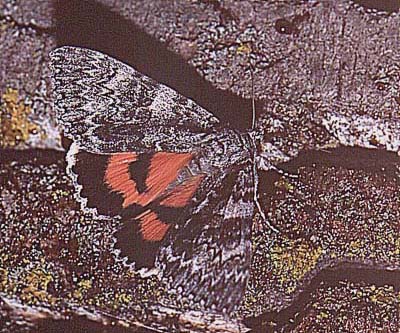
Catocala semirelicta courtesy of
John Acorn |
FLIGHT TIMES AND PREFERRED FOOD PLANTS:
Catocala semirelicta flies as a single generation with moths on the wing from June to September.
Tim Dyson attracted this specimen to bait on July 20, 2005 in Peterborough, Ontario.
The diffuse dark bar, paralleling the inner margin of the forewing, is diagnostic for this species at rest.
| 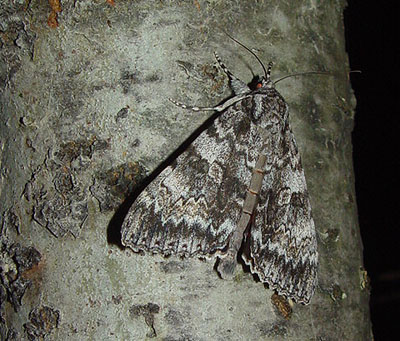
|
The first time I saw the image to the right, I thought it was Catocala unijuga, mostly because of the absence
of the diffuse dark bar usually present on the lower quarter of the forewing, paralleling the inner margin. However,
the subreniform spot is open and the second of the larger teeth in the pm line is not as reduced as in typical C. unijuga.
The subreniform spot also shows the yellowish scaling that is present outside the pm line.
Image (right), Peterborough, Ontario, August 25, 2004, courtesy of Tim Dyson copyright.
| 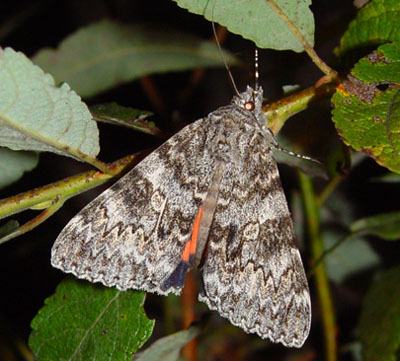 |
Semirelicta tend to have hindwing inner bands that terminate well before the inner margins.
Meskei tend to have a narrower band and a dustier (less distinct) looking forewing.
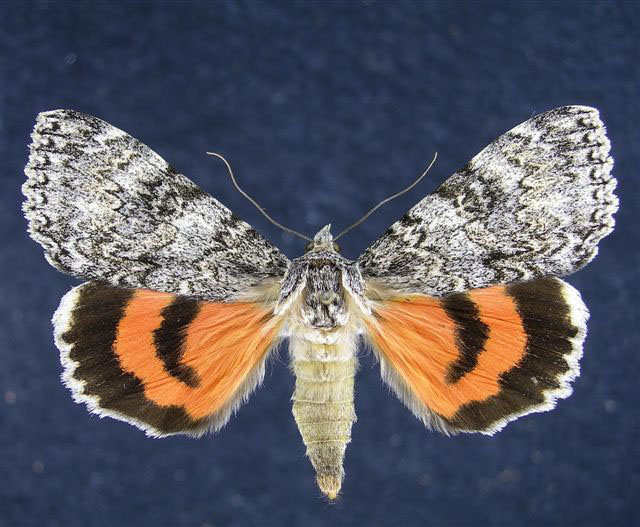
Catocala semireclicta, 60 mm, courtesy of Jim Vargo.
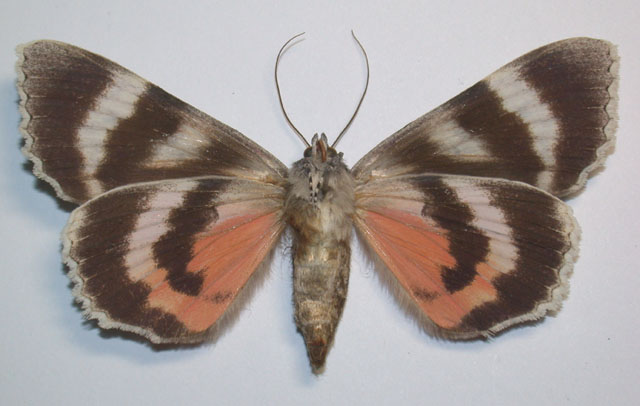
Catocala semirelicta female, LaMalbaie, Quebec,
courtesy of Pierre De Tonnancour, August 20, 1994, via Pierre Legault.
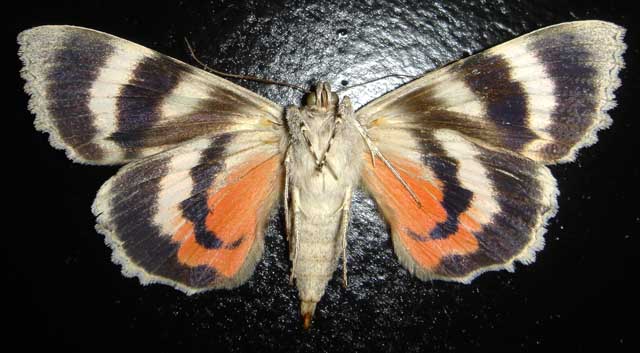
Catocala semirelicta female, the Semirelict Underwing, Regina, Saskatchewan,
73mm, August 27, 2009, Tim Taylor.
Note the hw cell is completely dark, and red scaling usually terminates before reaching the cell.
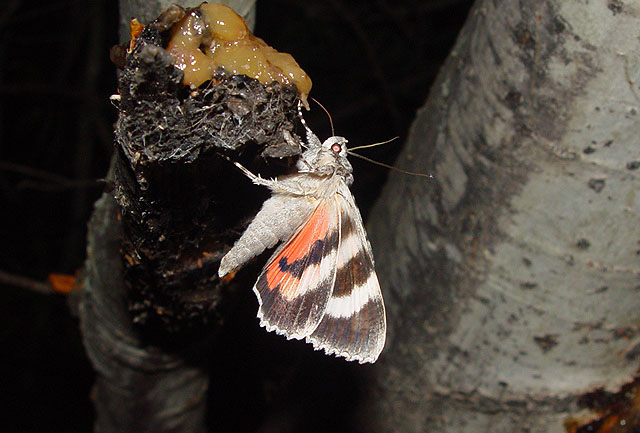
Tim Dyson is one of the few nature photographers who can consistently come up with outstanding images of the undersides of these moths.
Note the dark hindwing cell. In this specimen, the red in the basal area advances beyond the cell.
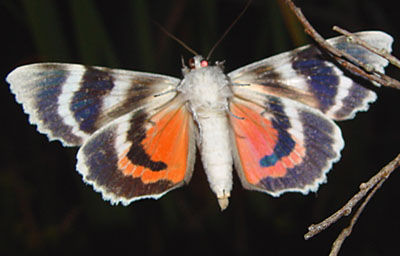 |
You won't often see a live semirelicta in flight, captured the way Tim Dyson has captured this one. Note the wide black banding on the
forewing and the narrow discal lunule in the hindwing cell. These features help to identify semirelicta from some similar relatives.
Catocala semirelicta, Peterborough, Ontario, August 25, 2004, Tim Dyson
copyright.
The hindwing inner black band also terminates well before the inner margin. |
Moths come in to lights readily and also to bait. Tim is using a banana mash bait in the
photo above. Mixed with a bit of alcohol, the bait renders the moths much less skittish after a couple of minutes at the brew.
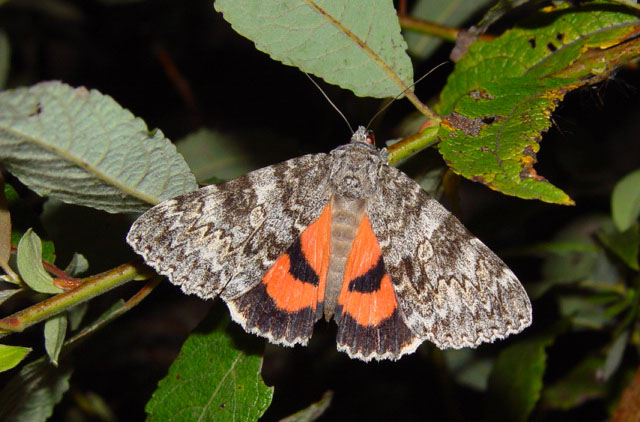
Catocala semirelicta, Peterborough, Ontario, August 25, 2004, courtesy of Tim Dyson, copyright.
The Catocala semirelicta caterpillar show a preference for poplars and willows.
This recent submission from Ron White seems to indicate that Catocala semirelicta is still present in New Hampshire.
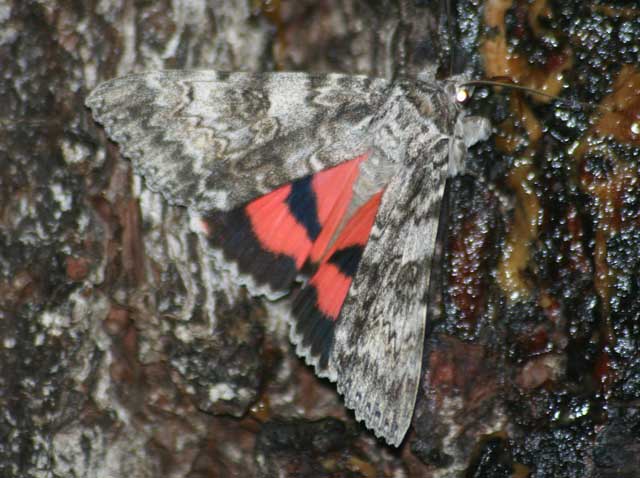
Catocala semirelicta Lancaster, Coos County, New Hampshire,
July 28, 2016, courtesy of Ron White, id by Bill Oehlke.
ECLOSION:
Adults eclose from pupae formed under leaf litter.
SCENTING AND MATING:
Catocala semirelicta females emit an airbourne pheromone and males use their antennae to track the scent plume.
EGGS, CATERPILLARS, COCOONS, AND PUPAE:
Eggs are deposited on bush bark in the fall and hatch the following spring.
Mature larvae Image courtesy of |
 |
Larval Food Plants
Listed below are primary food plant(s) and alternate food plants. It is hoped that this alphabetical listing followed by the common
name of the foodplant will prove useful. The list is not exhaustive, although some species seem very host specific.
Experimenting with closely related foodplants is worthwhile.
Populus balsamifera
Populus tremuloides......
Salix
|
Balsam Poplar
Quaking Aspen
Willow
|
Use your browser "Back button to return to the previous page.
Goto Main Catocala Index
This page is brought to you by Bill Oehlke and the
WLSS. Pages are on space rented from Bizland. If you would like to become a "Patron of the Sphingidae/Catocala Sites",
contact Bill.
Please send sightings/images to Bill. I will do my best to respond to requests for identification help.
Enjoy one of nature's wonderments: Live Saturniidae (Giant Silkmoth) cocoons.

|

To show appreciation for this site, click on the flashing
butterfly to the left, a link to many worldwide insect sites. |
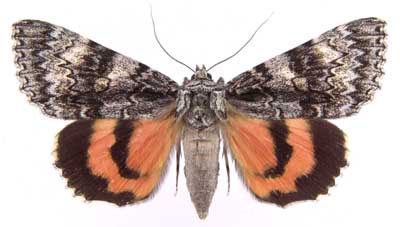
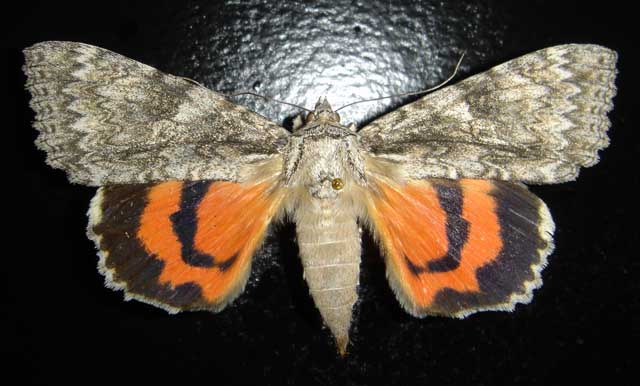
Catocala semirelicta female, the Semirelict Underwing, Regina, Saskatchewan,
73mm, August 27, 2009, Tim Taylor.
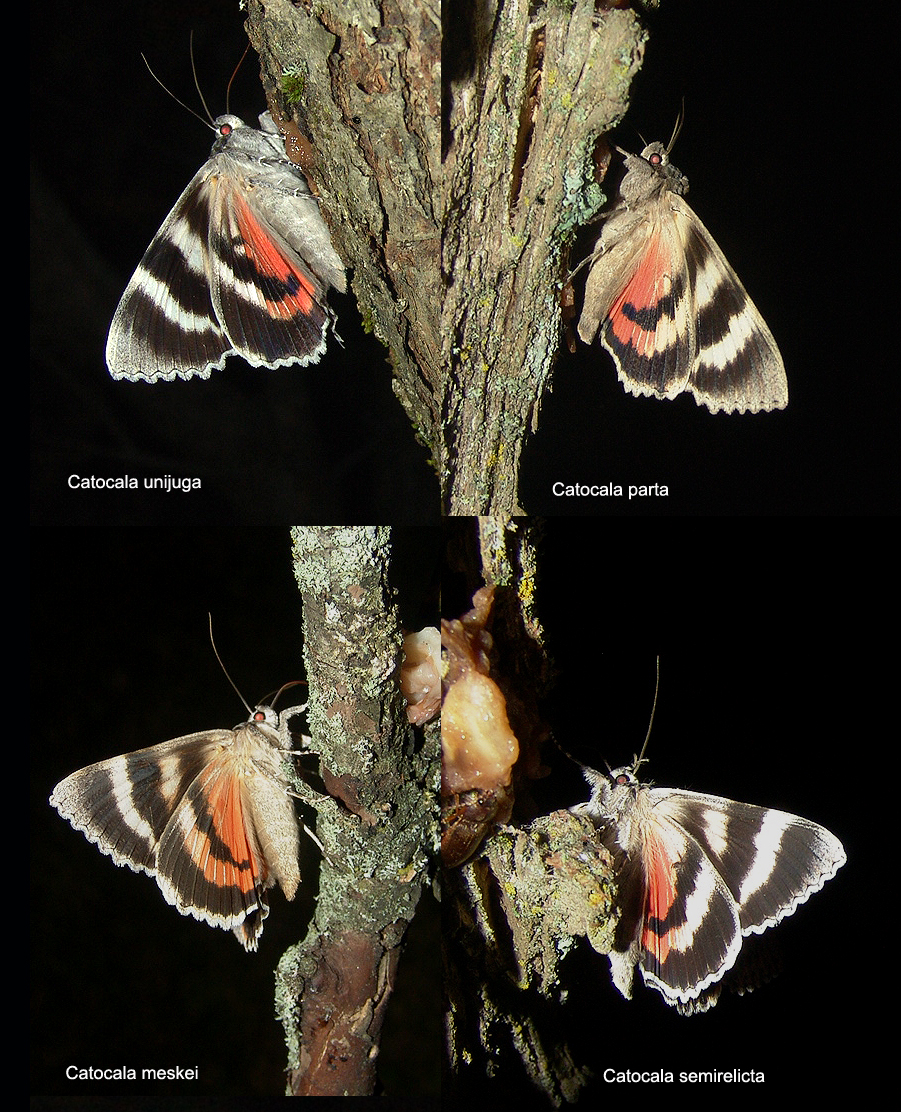
Catocala comparison Plate, Peterborough, Ontario,
courtesy of Tim Dyson.
Note strong presence of discal lunule in both unijuga and semirelicta.
Note very dentate nature of inner edge of outer black band on both the forewing and hindwing of parta.
The discal lunule is also very weak in parta, compared to other similar species.

















